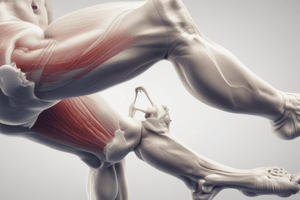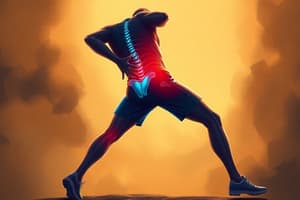Podcast
Questions and Answers
Which condition is most commonly associated with younger patients?
Which condition is most commonly associated with younger patients?
- Osteoarthritis
- Slipped capital femoral epiphysis (SCFE) (correct)
- Avascular necrosis
- Rheumatoid arthritis
What is the primary mechanism of injury in osteoarthritis?
What is the primary mechanism of injury in osteoarthritis?
- Trauma from a fall
- Inflammation from autoimmune response
- Mechanical wear and tear on joints (correct)
- Repetitive overuse injury
Which symptom is least associated with inflammatory conditions like bursitis or synovitis?
Which symptom is least associated with inflammatory conditions like bursitis or synovitis?
- Heat
- Change in structure
- Weakness in the gluteals (correct)
- Change in gait
What condition is characterized by the body’s immune system attacking its own joints?
What condition is characterized by the body’s immune system attacking its own joints?
What are common causes of bursitis?
What are common causes of bursitis?
Which of the following is NOT a symptom of hip joint inflammation?
Which of the following is NOT a symptom of hip joint inflammation?
What is the primary issue in Perthes disease?
What is the primary issue in Perthes disease?
In terms of age-related conditions, which is typically associated with older patients?
In terms of age-related conditions, which is typically associated with older patients?
Which of the following describes a characteristic of SUFE?
Which of the following describes a characteristic of SUFE?
Which form of arthritis is distinguished from rheumatoid arthritis due to its occurrence in children?
Which form of arthritis is distinguished from rheumatoid arthritis due to its occurrence in children?
Which type of hip fracture is considered an intracapsular fracture?
Which type of hip fracture is considered an intracapsular fracture?
What is a common treatment for SUFE?
What is a common treatment for SUFE?
What distinguishes the cam type of femoroacetabular impingement?
What distinguishes the cam type of femoroacetabular impingement?
Which of the following factors is NOT associated with Perthes disease?
Which of the following factors is NOT associated with Perthes disease?
Developmental Dysplasia of the Hip (DDH) is characterized by what primary abnormality?
Developmental Dysplasia of the Hip (DDH) is characterized by what primary abnormality?
Which statement about hip dislocations is true?
Which statement about hip dislocations is true?
What is indicated by the complete movement of the femur out of place?
What is indicated by the complete movement of the femur out of place?
Which condition refers to the femur being poorly seated but not completely out of its socket?
Which condition refers to the femur being poorly seated but not completely out of its socket?
What can result from untreated DDH in early diagnosis?
What can result from untreated DDH in early diagnosis?
What might be an initial treatment for a child diagnosed with DDH?
What might be an initial treatment for a child diagnosed with DDH?
Which of the following describes anteversion of the femur?
Which of the following describes anteversion of the femur?
What could potentially occur spontaneously as a hip develops in a child?
What could potentially occur spontaneously as a hip develops in a child?
In assessing a child with DDH, which symptom might be observed at birth?
In assessing a child with DDH, which symptom might be observed at birth?
What is a key factor influencing the treatment complexity of DDH?
What is a key factor influencing the treatment complexity of DDH?
Flashcards
Bursitis
Bursitis
Inflammation of a bursa, a fluid-filled sac that cushions tendons and bones around joints.
Arthritis
Arthritis
A condition that causes inflammation and pain in the joints and surrounding tissues.
Rheumatoid arthritis
Rheumatoid arthritis
An autoimmune disease where the body's immune system attacks its own joints.
Juvenile idiopathic arthritis
Juvenile idiopathic arthritis
Signup and view all the flashcards
Avascular Necrosis
Avascular Necrosis
Signup and view all the flashcards
Osteoarthritis
Osteoarthritis
Signup and view all the flashcards
Inflammation
Inflammation
Signup and view all the flashcards
Slipped Capital Femoral Epiphysis (SCFE)
Slipped Capital Femoral Epiphysis (SCFE)
Signup and view all the flashcards
Perthes Disease
Perthes Disease
Signup and view all the flashcards
Hip Fracture (Top 1/4 Femur)
Hip Fracture (Top 1/4 Femur)
Signup and view all the flashcards
Intracapsular Fracture
Intracapsular Fracture
Signup and view all the flashcards
Extracapsular Fracture
Extracapsular Fracture
Signup and view all the flashcards
SUFE (SCFE)
SUFE (SCFE)
Signup and view all the flashcards
Hip Dislocation
Hip Dislocation
Signup and view all the flashcards
Total Hip Replacement (THR)
Total Hip Replacement (THR)
Signup and view all the flashcards
Femoroacetabular Impingement
Femoroacetabular Impingement
Signup and view all the flashcards
Developmental Dysplasia of the Hip (DDH)
Developmental Dysplasia of the Hip (DDH)
Signup and view all the flashcards
Hip Subluxation
Hip Subluxation
Signup and view all the flashcards
Femoral Anteversion and Retroversion
Femoral Anteversion and Retroversion
Signup and view all the flashcards
Subluxation
Subluxation
Signup and view all the flashcards
Hip Subluxation
Hip Subluxation
Signup and view all the flashcards
Femoral Anteversion and Retroversion
Femoral Anteversion and Retroversion
Signup and view all the flashcards
Subluxation
Subluxation
Signup and view all the flashcards
Study Notes
HIP CLINICAL CONDITIONS
- Hip conditions are categorized by patient age group.
YOUNGER PATIENTS
- Apophysitis: Athletic injury, fracture, or dislocation.
- Bursitis: Inflammation of the bursa.
- Cam deformity / Femoroacetabular impingement: Abnormal hip shape causing rubbing.
- Congenital Hip Dysplasia: Developmental hip dislocation.
- Juvenile Idiopathic Arthritis / Juvenile Rheumatoid Arthritis: Inflammation of the hip joint.
- Perthes (Avascular necrosis): Death of bone cells due to poor blood supply.
- Slipped Capital (Upper) Femoral Epiphysis (SCFE / SUFE): Growth plate fracture, causing the head of the femur to slip out of place.
- Synovitis: Inflammation of the synovial membrane.
OLDER PATIENTS
- Avascular Necrosis: Death of bone cells due to poor blood supply.
- Bursitis: Inflammation of the bursa.
- Neck of Femur Fractures (NOF #): Fracture of the femur's neck.
- Osteoarthritis: Degeneration of cartilage in the hip joint.
- Rheumatoid Arthritis: Autoimmune disease causing inflammation of joints.
- Synovitis: Inflammation of the synovial membrane.
- Total Hip Replacement (THR): Surgical replacement of the hip joint.
INFLAMMATION = ITIS
- Pain, Swelling, Heat, Limp are key symptoms used to identify inflammation in the hip.
- Change in gait and structure can be due to conditions like apophysitis and juvenile arthritis.
- These conditions can sometimes be quite aggressive before treatment.
ARTHRITIS
- Osteoarthritis: Caused by wear and tear on the joint.
- Rheumatoid Arthritis: Autoimmune disease attacking the joint.
- Juvenile Idiopathic Arthritis: Autoimmune inflammatory condition, with different types (oligoarthritis, polyarthritis, systemic, psoriatic, enthesitis).
BURSITIS
- Repetitive stress (overuse) injury is a common cause.
- Hip injury, spine issues, leg length difference, weak glutes, rheumatoid arthritis, or previous hip surgery can increase the risk of bursitis.
- Bone spurs or calcium deposits can also cause the condition.
AVASCULAR NECROSIS
- Mechanical disruption (broken hip)
- Alcoholism, Excessive steroid use, Post-trauma (injury), Thrombosis (blood clot), and Hypertension (high blood pressure) can all cause avascular necrosis.
PERTHES "DISEASE"
- A childhood hip condition where blood supply to the femoral head is temporarily disrupted, causing avascular necrosis.
- It involves stages of necrosis, fragmentation, reossification, and healing, which can take 1-2 years.
HIP FRACTURES (TOP ¼ FEMUR)
- Femoral Neck Fracture: A break in the femur's neck
- Intertrochanteric Fracture: Fracture between the two bony protrusions (trochanters) on the femur.
INTRA / EXTRACAPSULAR FRACTURE
- Fracture location in the hip can be categorized as intracapsular (within the hip joint capsule) or extracapsular (outside the hip joint capsule).
- Types include intertrochanteric, subtrochanteric, and transcervical fractures.
HIP FRACTURE MANAGEMENT
- Surgical management is common, often involving the implantation of screws or plates.
SUFE (SCFE)
- A growth plate fracture where the head of the femur slips out of place.
- It's not typically associated with an injury; instead, puberty hormones and weight gain are significant factors.
- Early diagnosis and treatment are essential, often involving surgery.
- Sudden or slow onset of pain in the groin, hip, thigh, or knee, along with reduced movement, can be symptoms
HIP DISLOCATION
- Anterior or posterior displacement of the femoral head from the hip socket.
TOTAL HIP REPLACEMENT (THR)
- Surgical procedure to replace the hip joint with artificial components (hemi or total).
FEMORACETABULAR IMPINGEMENT
- A condition where extra bone growth in the hip joint can form an irregular shape (pincer or cam deformity). This can lead to pinching and rubbing, causing hip pain and other symptoms.
DEVELOPING DYSAPLASIA (DDH)
- A condition in which the hip joint doesn't develop correctly, potentially causing dislocation, or subluxation.
- Sometimes described as "clicky hips".
ROTATION OF FEMUR
- Anteversion (inward rotation) or retroversion (outward rotation) of the femur. These affect how a person walks
HIP CONDITIONS IN CHILDREN
- This section likely includes various hip conditions, such as dysplasia, dislocation, avascular necrosis, and others specific to developing children's anatomy.
Studying That Suits You
Use AI to generate personalized quizzes and flashcards to suit your learning preferences.




